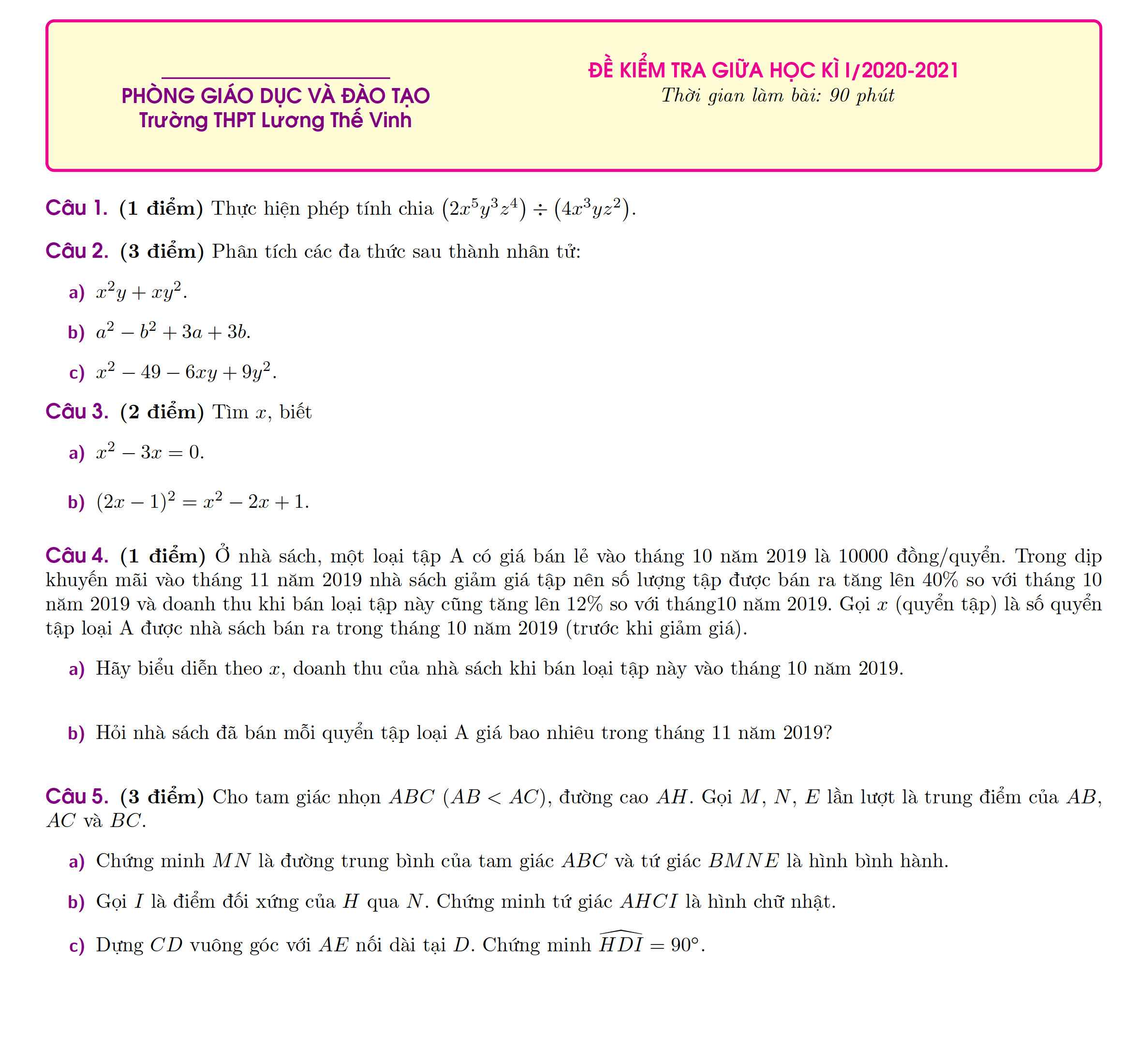
Hãy nhập câu hỏi của bạn vào đây, nếu là tài khoản VIP, bạn sẽ được ưu tiên trả lời.


a) \(A=\dfrac{1}{x+5}+\dfrac{2}{x-5}-\dfrac{2x+10}{\left(x+5\right)\left(x-5\right)}\)
\(A=\dfrac{x-5+2x+10-2x-10}{\left(x+5\right)\left(x-5\right)}=\dfrac{x-5}{\left(x+5\right)\left(x-5\right)}=\dfrac{1}{x+5}\)
b) \(A=-3\Rightarrow\dfrac{1}{x+5}=-3\)
\(\Leftrightarrow x+5=-\dfrac{1}{3}\Leftrightarrow x=-\dfrac{1}{3}-5=\dfrac{-16}{3}\)
\(9x^2-42x+49=\left(3x-7\right)^2=\left(3.\dfrac{-16}{3}-7\right)^2=\left(-23\right)^2=529\) \(\left(x=\dfrac{-16}{3}\right)\)

Bài 2:
Xét ΔABC vuông tại A có \(BC^2=AB^2+AC^2\)
hay BC=10(cm)
Ta có: ΔABC vuông tại A
mà AM là đường trung tuyến
nên AM=BC/2=5(cm)

Câu 5:
a: Xét ΔABC có
M là trung điểm của AB
N là trung điểm của AC
Do đó: MN là đường trung bình của ΔABC
SUy ra: MN//BE và MN=BE
hay MNEB là hình bình hành

Sau khi giảm \(15\%\) thì giá mới là \(500000-500000\cdot15\%=4250000\left(đồng\right)\)

\(a,=\dfrac{12x^2y\left(x+y\right)^2:3x\left(x+y\right)}{3x\left(x+y\right):3x\left(x+y\right)}=4xy\left(x+y\right)\\ b,=\dfrac{x^2+6x+9+24-x^2+4x-3}{4\left(x-3\right)\left(x+3\right)}=\dfrac{10\left(x+3\right)}{4\left(x-3\right)\left(x+3\right)}=\dfrac{4}{2\left(x-3\right)}\)

\(x\left(x^2-1\right)=6\)
\(\Leftrightarrow x^3-x-6=0\)
\(\Leftrightarrow x^3-2x^2+2x^2-4x+3x-6=0\)
\(\Leftrightarrow x^2\left(x-2\right)+2x\left(x-2\right)+3\left(x-2\right)=0\)
\(\Leftrightarrow\left(x^2+2x+3\right)\left(x-2\right)=0\)
\(\Leftrightarrow\orbr{\begin{cases}x-2=0\\x^2+2x+3=0\end{cases}}\)
\(\Leftrightarrow\orbr{\begin{cases}x=2\\\left(x+1\right)^2=-2\left(KĐS\right)\end{cases}}\)
Vậy x = 2 là ngiệm của pt trên.

Áp dụng bất đẳng thức \(AM-GM\) cho bộ ba số thực không âm gồm có \(x;\) \(x;\) \(2y\), khi đó, ta có:
\(x+x+2y\ge3\sqrt[3]{2x^2y}\)
\(\Leftrightarrow\) \(2\left(x+y\right)\ge3\sqrt[3]{2x^2y}\)
\(\Leftrightarrow\) \(6\ge3\sqrt[3]{2x^2y}\)
\(\Leftrightarrow\) \(2\ge\sqrt[3]{2x^2y}\) \(\Leftrightarrow\) \(2^3\ge2x^2y\) \(\Leftrightarrow\) \(8\ge2x^2y\) \(\Leftrightarrow\) \(x^2y\le\frac{8}{2}=4\)
Dấu \("="\) xảy ra \(\Leftrightarrow\) \(^{x=2y}_{x+y=3}\) \(\Leftrightarrow\) \(^{x=2}_{y=1}\)




